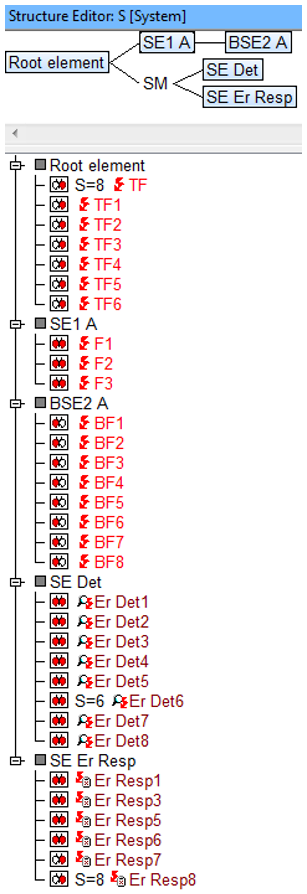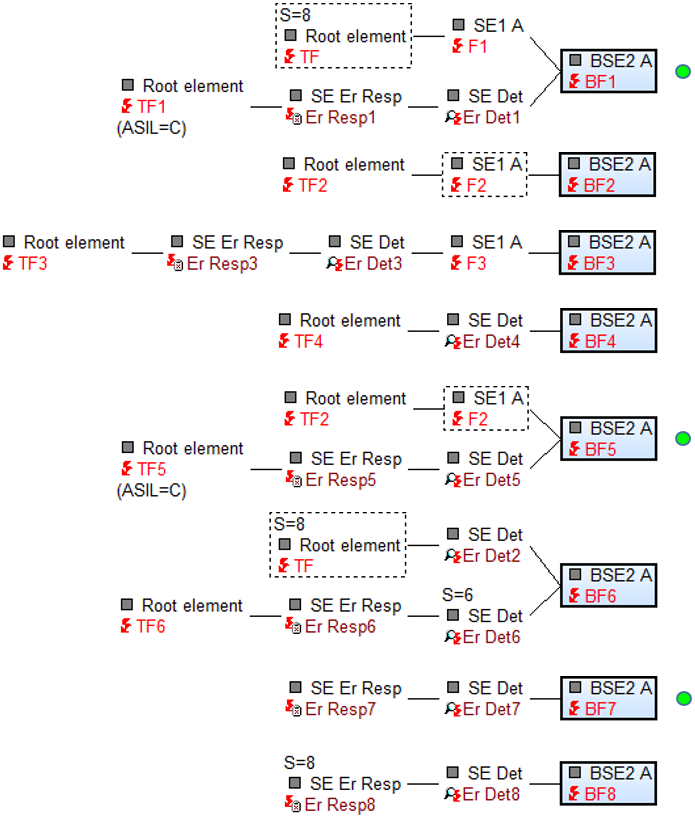Search:
Base failure(s) with missing safe S rating
Explanation:
A search will be performed for base failures, that are secured directly next to safety mechanisms (failure detection and failure reaction) in the failure net, whereby no S rating exists for the safety failure path.
Example:
Abbreviations
- ASIL = Automotive safety integrity level
- BF = Base failure of a base function
- BFn = Base function of a base structure element
- BSE = Base structure element
- Cl Prc = Classification for process characteristic
- Cl Prd = Classification for product characteristic
- Cl Req = Classification for requirement
- CM = Control method
- DA = Detection action
- DC = Diagnostic coverage
- DSCF = Dangerous safety critical failure
- Er Det = Error detection
- Er Resp = Error response
- F = Failure
- FIT = Failure in time
- Fn = Function
- FSM = Functional safety management
- IE = Inspection equipment
- LF = Latent fault
- LFM = Latent fault metric
- OC = Operating condition
- PA = Preventive action
- PE = Process element
- PFH = Probability of failure per Hour
- PMHF = Probabilistic metric for random hardware failures
- PrcC = Process characteristic
- PrdC = Product characteristic
- QM = Quality method
- QR = Quality rule
- Req = Requirement
- RMR = Risk Matrix Ranking
- RP = Reaction plan
- SE = Structure element
- SE ErDet = Structure element for error detections
- SE ErResp = Structure element for error responses
- SFF = Safe failure fraction
- SG = Safety Goal
- SIL = Safety integrity level
- SM = Organisational-SE for “safety mechanisms”
- SPF = Single point fault
- SPFM = Single point fault metric
- TF = Top failure of a top function
- TFn = Top function at root element
- TS = Test sample

- The above structure contains eight base failures, which can be recognized with the hot-click icon
 . This icon (check display options if not visible in IQ-Software) indicates that the failure is connected to at least a further failure (in direction of effects) but has no failures in direction of causes. This can be seen more clearly in the image below (of the failure net) whereby the BF is found on the far right of the net and therefore has no causes.
. This icon (check display options if not visible in IQ-Software) indicates that the failure is connected to at least a further failure (in direction of effects) but has no failures in direction of causes. This can be seen more clearly in the image below (of the failure net) whereby the BF is found on the far right of the net and therefore has no causes. - The structure also contains fourteen safety mechanisms in total, of which eight are failure detections (Det; Hot-click icon
 ) and six failure reactions (Reac; Hot-click icon
) and six failure reactions (Reac; Hot-click icon  ).
). - To see how the failures, failure detections and failure reactions are connected with- amongst each other see the failure net image below.
Failure Net Editor (failure net from viewpiont of BF):
According to the explanation, this QR should find ” base failures, that are secured directly next to safety mechanisms (failure detection and failure reaction) in the failure net, whereby no S rating exists for the safety failure path.”
Broken down into parts, this first means that the search must find all BFs that have a failure detection immediately next to it and a failure reaction immediately after that. It is not important which other types the BF is linked to.
From this first part, the search would deliver BF1, BF5, BF6, BF7 and BF8, as these are the only ones with a safety failure path.
With the display option “Severity” active, the S rating will be displayed next to the failures, failure- reaction and detections in the failure net.

Search result: ![]()
This QR will find the following base failures: BF1, BF5 and BF7.
BF2 will not be a hit as it does not have any immediate safety mechanisms. BF3 has both safety mechanisms but they are not directly linked to each other, as the failure-effect F3 is between them. BF4 is missing a failure reaction. BF6 contains a severity rating for the failure detection and is therefore not a hit. Finally, BF8 contains an S rating at the failure reaction.


